If you had a Caesarean section in the past, can you still have a vaginal birth in the future? This is a question that many mothers ask considering the 1 in 3 C-section rate here in Australia. Of these women, 84% will have another C-section. So is the old saying “once a caesarean, always a caesarean” true? In this blog, we will talk about VBAC – vaginal birth after caesarean.
Although it is your decision to have a VBAC or a planned caesarean, this decision needs to be discussed thoroughly with your medical provider. Whether a VBAC is suitable will depend on your health, your baby’s location and health. Understandably, your chances of a successful VBAC are higher if both of you are in good health and this pregnancy is progressing smoothly,
Why is the rate of repeat C-sections so high?
The main reason is the risk of uterine rupture. There are two types of uterine rupture due to VBAC:
- Catastrophic (symptomatic): This is when the old scar separates along its length, and the amniotic sac ruptures. The baby is pushed into the abdominal cavity, which results in heavy bleeding. Not a good situation at all for both the mum and bub.
- Asymptomatic: This is when the old scar separates, but luckily, the amniotic sac stays intact. So your baby remains in the uterus, causing only minimal bleeding. This is a more common and much better scenario than the first type, as the baby and mum usually survive.
As scary as uterine rupture sounds, the risk rupture is not incredibly high. A recent UK study estimated that the incidence of uterine rupture is 0.2%.The risk is higher in women with >2 previous C-section births or have not waited for more than 12 months since their last delivery. In addition, rupture is more likely if women were induced or used oxytocin. When might your doctor recommend a planned caesarean?
When might VBAC be unsuitable for you?
There are certain conditions that are risky to have a VBAC, and thus it will be safer to elect a caesarean birth:
- Pregnancy complications (eg. high blood pressure, breech position, concerning size or health of your baby)
- You’ve had 3 or more caesareans
- Your previous caesarean was a vertical cut in your abdomen, which is rare in Australia
- Your uterus ruptured previously
- You have had previous surgery done to your uterus, eg. removing fibroids
- You have a multiple pregnancy (eg. twin)
Benefits of VBAC
Enough of the possible side effects of VBAC, what about some benefits? Just like any vaginal delivery, VBACs do come with these benefits:
- Lower risk of certain health problems, such as infections and respiratory problems
- Shorter recovery time and hospital stay
- More likely to feed and have skin time with your baby straight after birth
- Lower risk of future pregnancy complications
- Less abdominal pain after birth
If you would like to have a VBAC for your current or next pregnancy, make sure that you discuss this with your doctor as early as possible. If your obstetrician and midwife think that a VBAC is likely successful and safe, you can start discussing a suitable location to do VBAC. But do still make emergency C-section arrangements in case things don’t go as planned. It is highly recommended that you deliver a baby through VBAC in a hospital rather than a birthing Centre or at home.
For more information, you can contact Melbourne-based obstetrician Dr Alex Polyakov here.
